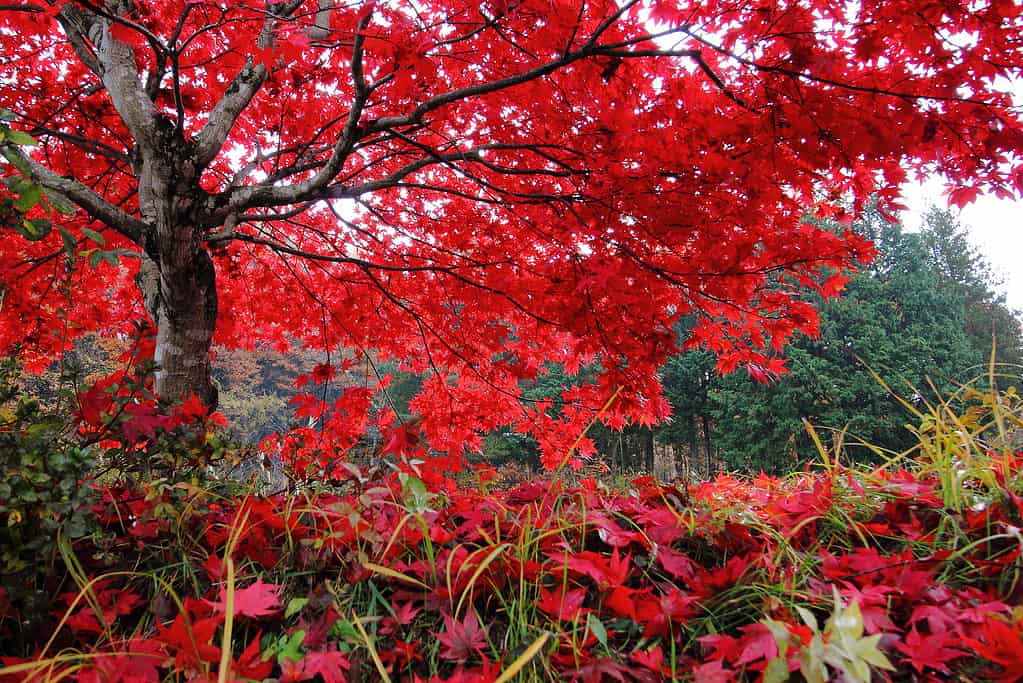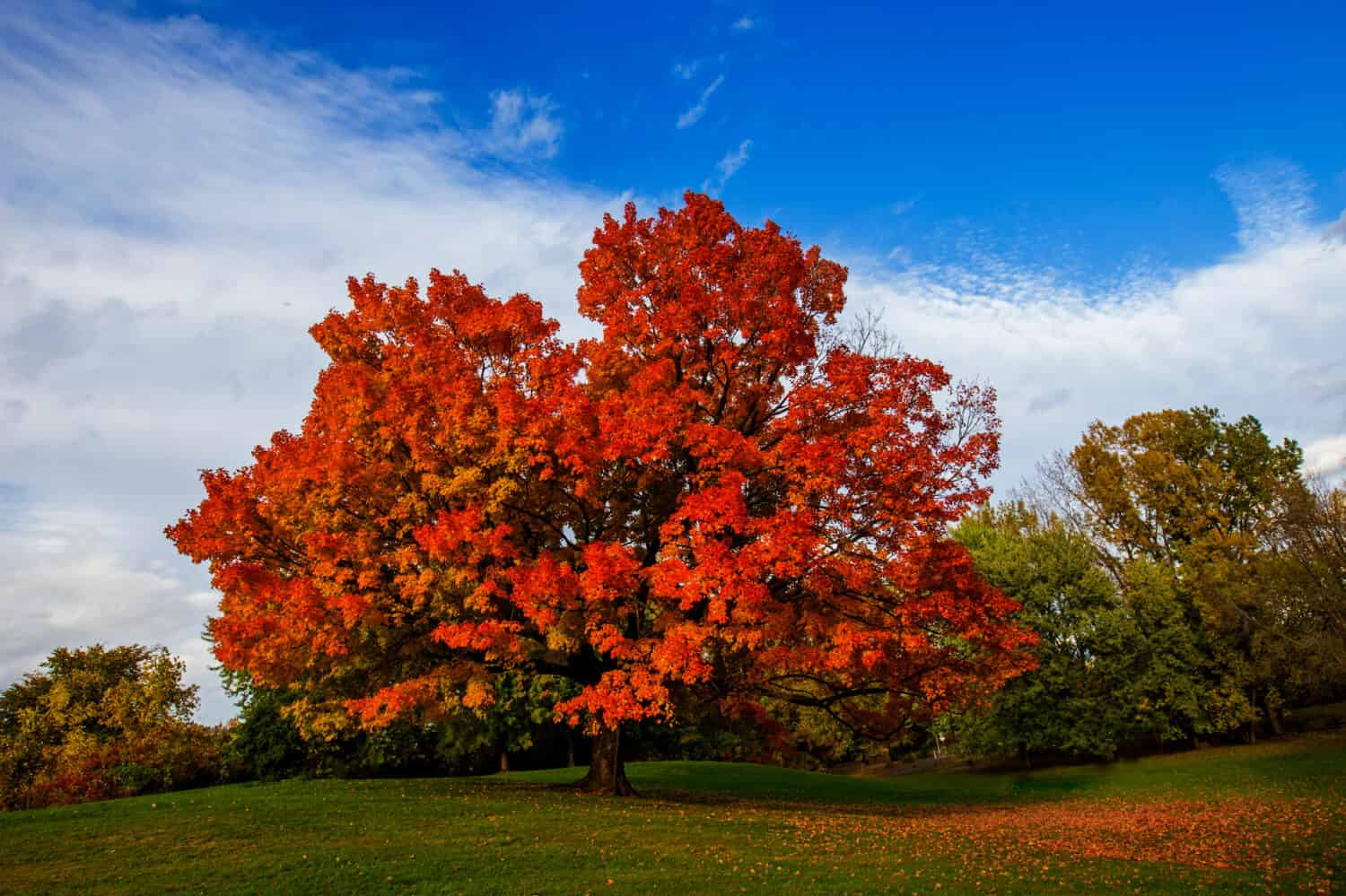
Both the red maple and the sugar maple belong to the Acer genus. Both are big, fast-growing, long-lived trees that delight us with their brilliant fall foliage among other attributes. It might be hard to tell them apart, but it can be done. Here are some of the differences between the red maple and the sugar maple.
The Red Maple

The red maple certainly lives up to its name in the fall.
©KungChuyada/Shutterstock.com
Very adaptable to different growing conditions, the red maple is found as far north as Newfoundland, as far south as Florida and as far west as eastern Texas. It flourishes at sea level and as far up as 3,000 feet. Its leaves are not only a glorious red in the fall, but so are its seeds, twigs, buds, flowers and leafstalks. Since the flowers and buds appear on the tree before the leaves, the tree appears to have a shimmering red haze about it even in late winter or earliest spring. The red maple’s scientific name is Acer rubrum.
Other Names
The red maple loves to grow around water, so its other names include water maple, swamp maple, and soft maple. Despite these names, the red maple is also found growing in soil that’s poor and dry.
What It Looks Like
Red maples grow from around 90 to 120 feet tall, and the diameter of the trunk is usually between 18 and 35 inches. In a forest, the trunk is branchless until you get pretty high up the tree. Trees grown in parks or gardens are shorter and thicker, and those that struggle in poor soils are scraggly and twisted. The shape of the crown is round or oval, and the bark of a young tree is smooth and pale gray. As the tree matures the bark darkens and develops aesthetically pleasing fissures.
Differences Between Red and Sugar Maple: Leaves
The best way to tell the difference between the red maple and the sugar maple is to look at the leaves. The leaves of both trees are deciduous, which means they fall in the autumn. Those of the red maple are palm-shaped, 2 to 4 inches long with three to five toothed lobes. The spaces between the lobes are narrow, and if the leaf has five, the top three are larger than the bottom two. The top side of the leaf is a bright green, while the underside has a pale bluish-green-gray bloom and may be fuzzy. The leafstalks, or petioles can be 4 inches long.
Though the leaves can turn a scorching red in autumn, they can also be orange or yellow. Leaf color depends largely on the quality of the soil, and the color is more intense in cooler climates. The color of the flowers depends on the sex. Female flowers tend to be more orange while male flowers are more red. Some red maple trees are female, some are male, and some have both sexes. The tree can also switch sexes. Red maples start producing flowers when they’re about eight years old. The flowers appear in clusters that can be all male, all female, or contain both sexes. They have no stalk and appear to grow directly on the twig.
Red Maple Seeds Ripen in Spring
The flowers are followed by winged samaras that are 0.625 to 1 inch long. One of the differences between the red maple and the sugar maple, indeed, most maples, is that they mature in spring and summer as opposed to fall. In some trees, the samaras are ripe even before the tree has leafed out. They too can be reddish but they can also be light brown. The seeds the samara holds are small, but a tree can produce tens of thousands of them in a season.
The reddish twigs of A. rubrum have tiny pores and sometimes small shoots. They may also have scars from where a leaf fell off. Flower buds are scaly and large, and they appear in the fall and winter.
How Long It Lives
The red maple can live as long as 150 years, though most die when they’re a century old or less. Though it’s very adaptable and hardy, the tree has thin bark that’s easy to damage. The damage can come from anything from hungry deer, lawnmowers, pathogens, and storms. On the other hand, the red maple grows strong roots and can tolerate periods of drought and flooding. The red maple’s conservation status is least concern.
Uses
The red maple can actually be used for maple syrup, but not to an extent as the sugar maple. In gardens and parks, it’s planted for its fall foliage and for its shade. The tree is also used as food for deer and squirrels. Moth and butterfly caterpillars use the tree as a host plant. They include the beautiful rosy maple moth, the huge Io, Polyphemus, Cecropia, and Promethea moths, and smaller moths such as the Satellite, Setaceous Hebrew Character, and the Engrailed.
The wood of the red maple is considered “soft,” even though it’s not really soft. It’s just that it’s not as dense and has a softer texture than what’s considered “hard” maple. It’s also less expensive. Red maple wood is used to make furniture, veneers, and musical instruments.
Caveats
The leaves of the red maple are dangerous to horses. Interestingly, scientists don’t know exactly what the toxin is, but it destroys the horse’s red blood cells and can lead to death if it’s not neutralized.
The Sugar Maple

One of the differences between the maples is that the sugar maple needs cold winters.
©Mircea Costina/Shutterstock.com
Like the red maple, the sugar maple is prized for its spectacular autumn foliage. It’s also the most commonly used maple tree when it comes to the production of maple syrup. One of the differences between the trees is that the sugar maple has a more northerly range than the red maple and it’s very rare south of the 42nd parallel. This is because the tree needs winters that bring hard freezes. The tree cannot even produce the sap that’s used to make syrup without these freezes. Though it can thrive in poor soils, it prefers soil that’s fertile and does best in full sunlight.
Other Names
The other names of this beautiful tree include sweet maple, curly maple, sugar tree, rock maple, and birds-eye maple. When it comes to the timber, it’s considered “hard” maple as opposed to the red maple’s “soft” maple.
What It Looks Like
The sugar maple usually grows to between 80 and 115 feet in height with a round or oval crown. If it grows in the forest, the trunk is straight and branches don’t appear until well up the tree. The lobes of its palmate leaves have deep notches and fine points, and there are usually five lobes. The leaves are about 7.9 inches long with a similar width. The leaves turn intense scarlet, gold, yellow, and orange colors in the fall. Sometimes one part of the tree changes color while other parts of the tree stay green for a while. Some trees show all the aforementioned colors at the same time, making for a jaw-dropping display.
Differences Between Trees Include Their Flowers
Unlike the red or orange flowers of the red maple, the flowers of the sugar maple are yellowish green, and they appear in corymbs in early spring. Like the red maple, the sugar maple can have all male flowers, all female flowers, or a combination of both. The bark is gray and fluted, and the twigs are grayish-green and a bit frail. They turn brown as they mature. The pointed buds are always brown and never take on the red coloration of the red maple. This is another of the differences between the two trees.
Another of the differences between the sugar maple and the red maple is that its samaras ripen and fall in autumn. The seeds of the sugar maple also need to be exposed to temperatures below 39 degrees Fahrenheit before they can germinate. These temperatures break down the seed’s protective coating. However, the seed can’t start to sprout until the danger of frost is over, but it also can’t sprout if the temperature goes above 50 degrees F. The seeds of the red maple germinate much more easily.
Differences Between the Maples: Longevity
The sugar maple is a longer-lived tree than the red maple. It can and often does live for 200 years. Some trees are believed to be 300 years old. Most trees start to flower when they’re about 30 years old, another of the differences between it and the red maple.
Though it’s adaptable to different conditions, the sugar maple doesn’t tolerate floods or drought as well as the red maple. Its roots grow deeper than those of the red maple, whose roots tend to be shallow. The sugar maple can actually pull water up from the ground into the drier upper soil layers. This is called hydraulic lift, and it’s not only good for the tree but good for the plants around it.
Uses

This tree is being tapped for the sap that goes into making maple syrup.
©Marc Bruxelle/Shutterstock.com
The sugar maple is famously used to produce maple syrup, though other maples can also produce syrup. The syrup of the sugar maple is judged to be superior to that of other maples. For example, people say that the red maple’s syrup has an off taste because the tree produces seeds in the spring instead of the fall.
People make maple syrup by drilling a hole inside the bark of the tree and collecting pails of sap. The sap is then boiled, and syrup is left as the water boils off. If you’re wondering why maple syrup is pricey, consider that it takes 40 gallons of sap from a sugar maple to make a gallon of maple syrup. People also eat the tree’s seeds after they’re cooked. They also eat the inner bark and the just sprouted leaves.
The timber of the sugar maple can be quite attractive, with wavy, quilted, curly, birds-eye or flame figures. The wood is used as flooring for basketball courts and bowling alleys, for bowling pins, pool cues, and baseball bats, and for musical instruments. The timber of the Canadian sugar maple is sought after for the necks of electric guitars because of the beautiful clear sound it produces. During the Victorian era, sugar maples were planted in cities, but eventually, they couldn’t tolerate the pollution caused by cars or the salt spread to de-ice roads. Because of this, the sugar maple was replaced by its tougher cousins.
The sugar maple is also Vermont’s state tree. Its conservation status is also least concern.
Red Maple vs. Sugar Maple: Differences Between Them at a Glance
| Features | Red Maple | Sugar Maple |
|---|---|---|
| Height | 90 to 120 feet | 80 to 115 feet |
| Lifespan | About 100 years | Up to 300 years |
| Range | From Canada to Texas | Above 42nd parallel |
| Fruiting Season | Spring | Fall |
| Age of Flowering | 8 years | About 30 years |
| Main Uses | Shade, Foliage, Timber | Syrup, Foliage, Timber |
| Tolerant of Drought? | Yes | Not so much |
| Tolerant of Flooding? | Yes | No |
The photo featured at the top of this post is © KungChuyada/Shutterstock.com
Thank you for reading! Have some feedback for us? Contact the AZ Animals editorial team.







